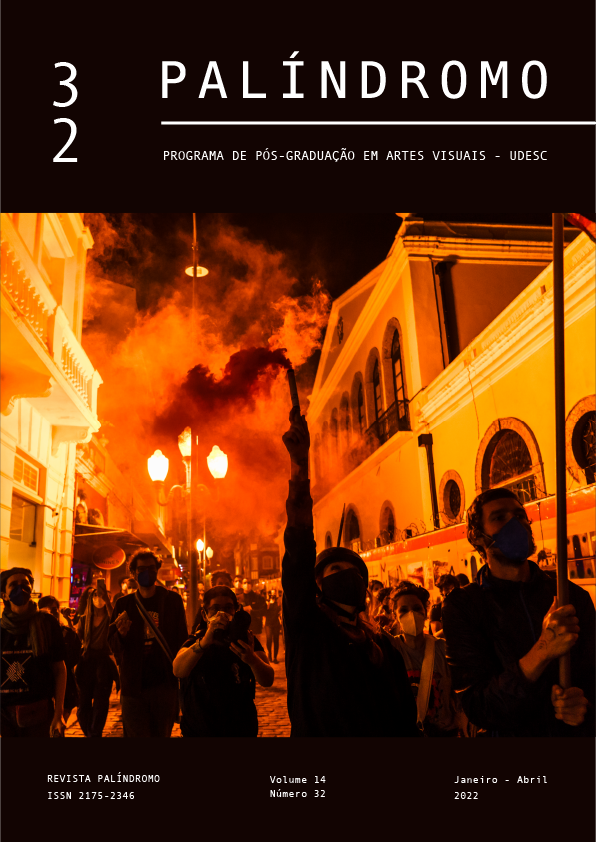La construcción de una mirada semiótico pedagógica en la formación docente en artes
DOI:
https://doi.org/10.5965/2175234614322022050Parole chiave:
Semiótica. Pedagogía. Formación Docente en ArtesAbstract
En el presente trabajo se problematizan los alcances que puede suponer el desarrollo de un enfoque semiótico-pedagógico en la formación docente en artes, en atención a la dimensión significante de las discursividades artísticas, de la dimensión estética de los discursos mediáticos contemporáneos y de los modos en que ambas se entraman en el desarrollo de la subjetividad de los actores sociales. A tales efectos, se interroga el modo en que se configura un complejo entramado de relaciones intersubjetivas en el encuentro pedagógico y cómo dicho espacio emergente opera a modo de matriz de base para el despliegue de un proceso de deconstrucción de las significaciones sociales. Luego de un recorrido por diferentes aspectos constitutivos del campo pedagógico y de aproximarnos a diversos rasgos vinculados con la politicidad inherente al acto educativo, se discute el modo en que la atención de la dimensión significante tanto de la praxis educativa como de los discursos artísticos puede conducir al desarrollo de un posicionamiento crítico y reflexivo como parte de una pedagogía crítica y transformadora. Finalmente, a modo de conclusión, se formulan algunos desafíos y contribuciones que puede suponer el desarrollo de esta perspectiva semiótico-pedagógica en la formación docente en artes.
Downloads
Riferimenti bibliografici
ANIJOVICH, R. Transitar la formación pedagógica. Dispositivos y estrategias. Buenos Aires: Paidós, 2009.
BRUNER, J. La educación, puerta de la cultura. Madrid: Machado Libros, 1997.
BUJÁN, F. Las tramas intersubjetivas del encuentro pedagógico: un abordaje semiótico-comunicacional focalizado en la diversidad. Comunicação & Educação, São Paulo, Departamento de Comunicações e Artes, Escola de Comunicações e Artes, Universidade de São Paulo (USP), ano XXIII, n. 2, pp. 109-119, 2018.
BUJÁN, F. La dimensión política de la práctica educativa: reflexiones semióticopedagógicas en torno a la formación docente en artes. Revista Diálogos en Mercosur, Santiago de Chile, n. 7, pp. 21-31, 2019.
CAMBLONG, A. & FERNÁNDEZ, F. Alfabetización semiótica en las fronteras. Dinámica de las significaciones y el sentido. Vol. 1. Posadas: Editorial Universitaria de la UNaM, 2012.
CULIOLI, A. Escritos. Buenos Aires: Santiago Arcos, 2010.
ECO, U. Los límites de la interpretación. Barcelona: Editorial Lumen, 1992.
GOODMAN, N. Maneras de hacer mundos. Madrid: La balsa de la Medusa, 1990 [1978].
GRECO, M.B. (2012) Una autoridad igualitaria en educación: construcciones, asimetrías y diálogos en el desarrollo profesional. In: BIRGIN, A. (comp.) Más allá de la capacitación. Debates acerca de la formación de los docentes en ejercicio.
Buenos Aires, Paidós, pp. 63-84, 2012.
MAGGIO, M. Enriquecer la enseñanza. Los ambientes con amplia disposición tecnológica como oportunidad. Buenos Aires, Paidós, 2012.
MEIRIEU, P. Frankenstein educador. Madrid: Editorial Laertes, 1998.
PEIRCE, Ch.S. La Ciencia de la Semiótica. Buenos Aires: Nueva Visión, 1978.
SERRES, M. Pulgarcita. El mundo cambió tanto que los jóvenes deben inventar todo: una manera de vivir juntos, instituciones, una manera de ser y conocer. Buenos Aires: Fondo de Cultura Económica, 2013.
SIBILIA, P. La intimidad como espectáculo. Buenos Aires: Fondo de Cultura Económica, 2008.
TEDESCO, J.C. Educar en la sociedad del conocimiento. Buenos Aires: Fondo de Cultura Económica, 2000.
TRAVERSA, O. Inflexiones del discurso. Cambios y rupturas en las trayectorias del sentido. Buenos Aires: Santiago Arcos, 2014.
VERÓN, E. La Semiosis Social. Fragmentos de una teoría de la discursividad. Barcelona: Gedisa, 1988.
VERÓN, E. La Semiosis Social, 2. Ideas, momentos, interpretantes. Buenos Aires: Paidós, 2013.
Downloads
Pubblicato
Come citare
Fascicolo
Sezione
Licenza
Copyright (c) 2021 Federico Buján

TQuesto lavoro è fornito con la licenza Creative Commons Attribuzione 4.0 Internazionale.
DECLARAÇÃO DE DIREITOS AUTORAIS
a. Os artigos publicados pela revista são de uso gratuito, destinados a aplicações acadêmicas e não comerciais. Todos os direitos autorais são atribuídos à revista. Os artigos cujos autores são identificados representam a expressão do ponto de vista de seus autores e não a posição oficial da Revista Palíndromo. O (s) autor (es) compromete-se sempre que publicar material referente ao artigo publicado no Palíndromo mencionar esta publicação da seguinte forma:
Este artigo foi publicado originalmente pela revista Palíndromo em seu volume (coloque o volume), número (coloque o número) no ano de (coloque o ano) e pode ser acessado em: http://www.revistas.udesc.br/index.php/palindromo
b. Plágio, em todas as suas formas, constitui um comportamento antiético de publicação e é inaceitável. A revista Palíndromo utiliza o software iThenticate de controle de similaridade


